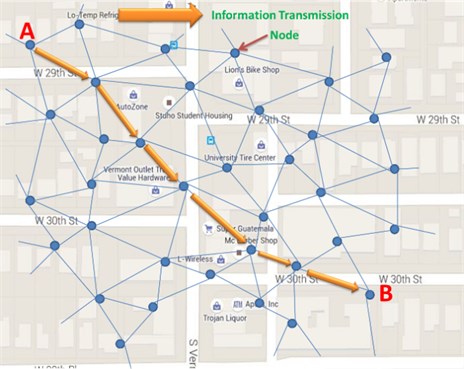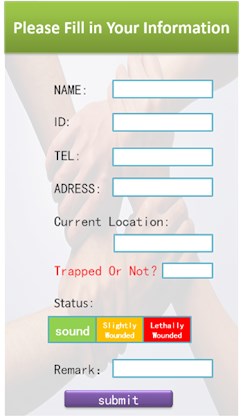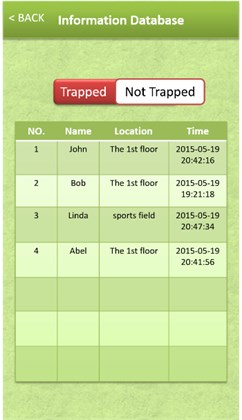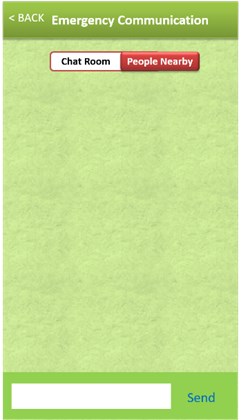Abstract
Devastating earthquake can often cause the disaster area communication interrupt, traffic paralysis, etc. It is difficult for the emergency rescue force to get the disaster area in time. Therefore, active local participation in the quake-hit areas to aid each other appeals extremely important. The paper is based on a self-developed smartphone software called “E-Explorer”, study its significance and its working methods to help the public participate in the earthquake rescue actively when external network are cut off. “E-Explorer” can help deliver important information for personal survival, let rescue workers locate the positions of survivors trapped, creating an efficient self-help and mutual rescue platform for the earthquake-stricken people.
1. Introduction
1.1. Background and significance
Earthquake causes a huge threat on people's lives and safety. After the earthquake occurrence, emergency relief is the top priority. For survivors in the rubble, time is life. The later the rescue forces arrived, the lower the hope of survivors. According to the Japan Kobe earthquake statistics, after the earthquake attack, 60 % of buried people died shortly, 40 % of buried people waited for rescue [1]. However, Due to traffic congestion and communication interruption, the disaster rescue team cannot rush to the disaster area in a short time. Thus, after the earthquake, people in disaster areas actively and efficiently involved in mutual aid in the earthquake zone is the most effective means to reduce casualties [2]. The fact also shows that the vast majority of people who survived in earthquake rely on self-help and mutual aid. This study was based on a self-developed smartphone software called “E-Explorer”. We are committed to creating an efficient self-help and mutual aid rescue platform for people in the earthquake-stricken areas, to help the public use smartphone to actively and efficiently participate in the rescue.
“E-Explorer” platform enables survivors trapped in the rubble initiatively issue distress signals. So it can let more people on the platform to find them and know their situation. It can also help survivors not trapped or rescuers find their trapped position. In high seismic intensity area, the outside network is cut off. “E–Explorer” using mobile phones to communicate by Bluetooth way. Its important information automatically transfer function is expected to help trapped people to pass vital information to relief workers. This paper studies E-Explorer‘s significance and its working methods for earthquake relief work under no external network in the high-intensity area.
1.2. Communication and rescue principle
“E-Explorer” is based on Multipeer Connectivity Framework technology in iOS7. In the absence of an Internet connection, it can make the device realize point-to-point, point to multi-point, and across the multipoint connection communication with nearby equipment via Bluetooth.
In the high seismic intensity area, the communication network is cut off. Trapped survivors can't effectively convey help Information by means of usual communication way. “E-Explorer” communication module provides a new way of information transmission. This module allows two mobile devices to exchange text and other formal information under the condition of no network connection. Through experimental verification, in the case of barrier-free, it can realize the communication within the scope of 30 to 40 m. In case there is an obstacle, the signal can pass through one or two thick walls blocked. So we can suppose that “E-Explorer” can still realize good communication with nearby people in the absence of any external network. Most important of all, each device equipped with “E-Explorer” software can be used as a node in the information transmission network, that is to say, everyone can communicate with the long-range goals by means of several number of nodes connected pairwise. Visual communication diagram are shown in figure 1 below. If the distance of two nodes is in the range of maximum communication distance, then there can build a "communication line" between them. Figure 1 shows the trapped survivors A through several nodes finally pass his help information to a relief worker B.
Fig. 1Personnel information transmission line schematic

“E-Explorer” builds a database, which stores important information for users under the special disaster background, such as name, position, whether you are trapped, injury status, and so on. Users need to fill in special information, and after confirmation, it can be saved to the database. Once there is another device also equipped with “E-Explorer” close to ones device, the two devices will be able to share respective information in the database automatically. So the important help information can be shared among the affected people in this way. As time goes by, more and more people will get the message of trapped survivors, which means their survival hopes will be greater. Because after other people or rescue workers getting these information, rescue work can be more efficient and targeted. In addition, if you need material help, you can also note it in “E-Explorer”. In fact, people’s various needs can be stored in the database, and through this platform to let others know their situation.
“E-Explorer” construct an information store and delivery platform. In addition, because that people is always in motion, finally someone might go out of the information isolated island, then he can transfer a large number of help information of the survivors he has already shared to the outside world. In this case, the outside world or rescue team can get some victims’ information about their trapped condition and location, and quickly take rescue measures.
1.3. The introduction of main functions and interfaces
The information inputting interface is shown in the Fig. 2.
The personal information interface is shown in the Fig. 3.
Fig. 2The information inputting interface

Fig. 3The information inputting interface

Fig. 4The communication interface

After opening the software, the users should input their own personal information, and the interface is shown in the Fig. 2, which concludes such as whether you are trapped, the state of your health and your trapped address and so on. You are supposed to finish and submit them. At this time the personal information of the users are uploaded to the database of the “E-Explorer” that can sort you into the green regions, which means you are not trapped, or the red regions, which means you are trapped, according to what you have submitted. AS long as you click the consent that permit opening the blue tooth, although without any network, the “E-Explore” is in a position to search the counterpart nearby automatically and to connect with it after matching successfully. Their connections will contribute to the information sharing between two databases, indicating that you can acquire the personal information of your partner and transmit the text message freely. Besides, when two users can’t connect with each other when the distance is too long, if there is one user who have opened his “E-Explorer” between them, which can be seen as a node to connect them, they could also realize mutual connections and information transmission. If the distribution of users in the region is extremely dense, any pairwise users within the scope of connection distance can achieve communication. That is to say the “E-Explorer” constructs a temporary communication network system in the earthquake region.
The communication interface is shown in the Fig. 4.
The communication interface, with an easy and clear lifestyle, can achieve free transmission of the text information between the users without any external network.
2. Experiment
2.1. The simulation
When earthquake struck, it is significant to realize the quick information delivery of the trapped people and make it known and stored by more persons. This experiment simulates a process that a person equipped with “E-Explorer” which flow between isolated trapped people who are also equipped with “E-Explorer” in the disaster area attains help information of the people he walk through. It aims to confirm the information collection and transmission function of “E-Explorer”. The process is shown in the Fig. 5.
Fig. 5The experiment of the information collection and transmission

2.2. The process of the experiment
1) Number the experimenters (1, 2, 3, 4, 5, 6, 7).
2) Make 1-6 experimenters on a route, with the distance between them exceeding the effective connection range, which is to say that the number 1 to 6 composed six isolated points and are unable to communicate with each other.
3) Cut off external network. Make everyone open “E-Explorer” and fill in their personal information, then the number 7 experimenter enters into the experimental field and walk through the number 1-6 experimenters (The number 7 experimenter can only connect with one isolated point at the same time, for example, at the beginning of the experiment, the number 7 experimenter connects the number 1 experimenter, while he comes close to the number 2 experimenter, he connects number 2, but lost connection with number 1.)
4) Number 7 leave the field and check whether all the help information of number 1-6 experimenters have been collected.
2.3. The result of the experiment
Number 7 experimenter obtained all the personal help information of number 1-6 experimenters. Consequently, this experiment illustrates that “E-Explorer” is able to accomplish help information collection and delivery on the condition of no external network.
3. Conclusions
For survivals trapped in earthquake ruins, time means life. Therefore, that people in disaster area actively carry out mutual aid in the earthquake zone is the foremost part in the emergency rescue. “E-Explorer”, which is based on mobile Bluetooth communication technology, can establish a temporary communication network to accomplish information delivery without any external network in the high intensity seismic zone. All of its interfaces and functions are designed according to earthquake background and rescue work requirement, and it is expected to help building an earthquake emergency rescue communication platform, contributing to facilitate efficient mutual aid for disaster survivals and provide more hope for trapped people.
References
-
Kuwata Y., Takada S. Rescue ability for earthquake casualty during the 1995 Kobe Earthquake. Departmental Bulletin Paper, 2000, p. 215-220.
-
Shu Y., Xu M., Liu Y. Self-help and mutual rescue – the relief work in serious earthquake. Journal of Hebei Institute of Technology: Social Science Edition, Vol. 3, Issue 3, 2003, p. 33-35.
